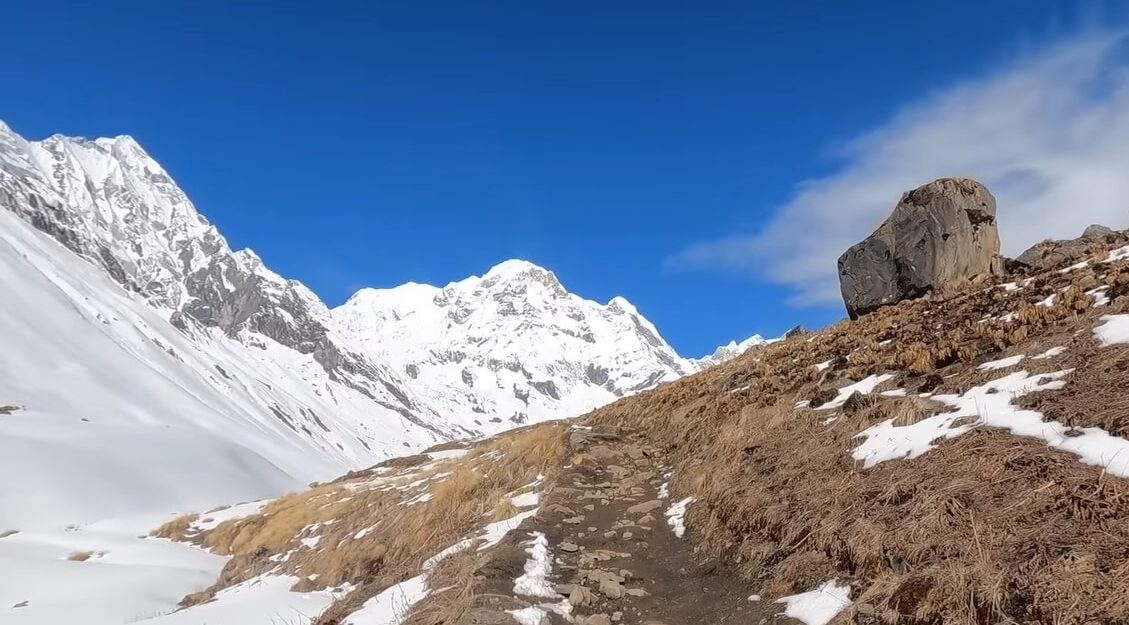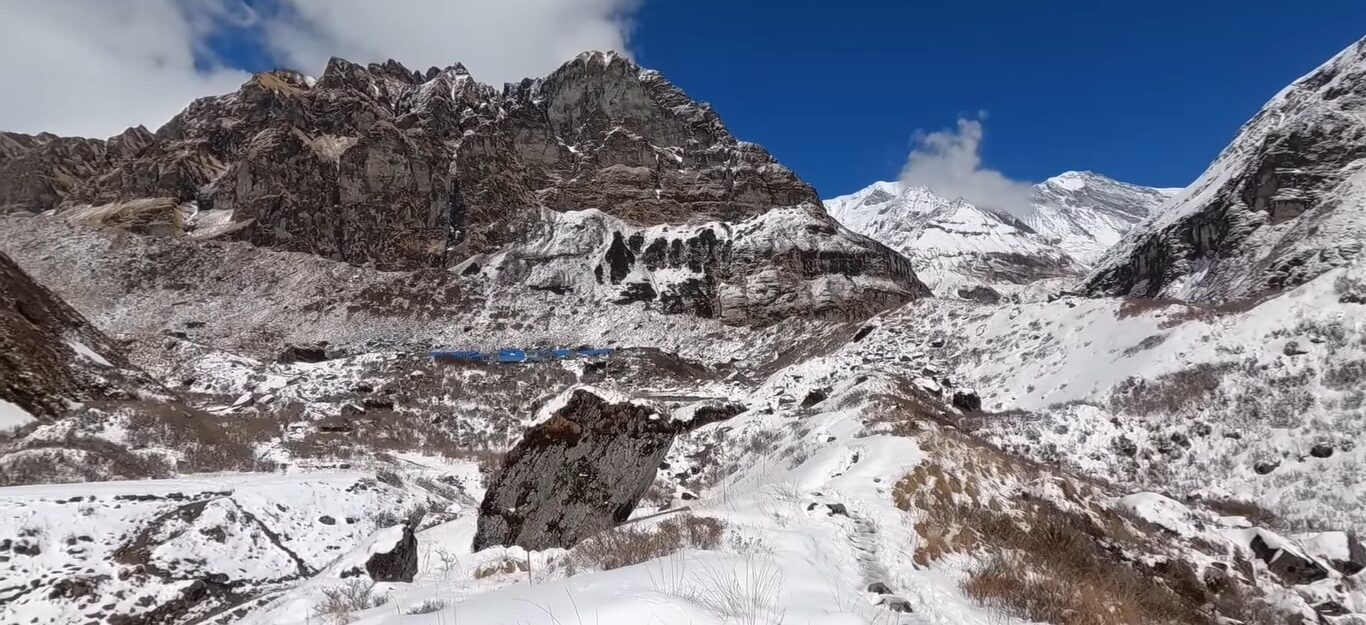
Annapurna Base Camp Trekking Routes
One of the most popular and beautiful treks in Nepal is the Annapurna Base Camp Trek. It takes you through diverse landscapes, including lush forests, cascading waterfalls, terraced fields, and majestic snow-capped mountains. The trek starts from the city of Pokhara and leads you to the base camp of the Annapurna massif, one of the highest mountain ranges in the world. This blog contains the Trekking routes to Annapurna Base Camp.
The trek is moderate in difficulty and suitable for all types of trekkers. It offers a unique cultural experience as you get to interact with the local communities and witness their traditional way of life. The trek can be completed in around 7-12 days, depending on the route and itinerary.
The Annapurna Base Camp Trek is a once-in-a-lifetime experience that offers breathtaking views, unforgettable memories, and a chance to connect with nature in a profound way.
The trek offers breathtaking views of snow-capped mountains, unique culture, and diverse landscapes. The trek is known for its challenging terrains, high altitudes, and varied flora and fauna.
In this blog, we will take you through everything you need to know about the Annapurna Base Camp Trek, including the best time to visit, trekking routes, accommodation options, permits, and safety tips.
Find More
- Annapurna Expedition in Autumn Season
- How to Handle Altitude Sickness while Climbing in Nepal
- Annapurna Expedition for Beginners
Best Time to Visit
The best time to visit the Annapurna Base Camp Trek is from March to May and September to November. During these months, the weather is stable, and the skies are clear, providing stunning views of the mountains.
The temperatures are mild during the day, making it easier for trekkers to navigate through the challenging terrains. However, during the peak season, the trekking routes can get crowded, and the prices for accommodation and permits can be high.
Trekking routes to Annapurna Base Camp – 2 Routes
There are two popular trekking routes for the Annapurna Base Camp Trek.
- The classic route is a 10 to 14 days trek that starts and ends in Nayapul. The trek passes through Poon Hill, Ghorepani, Tadapani, Chomrong, Dovan, Machhapuchhre Base Camp, and finally, the Annapurna Base Camp.
- The alternative route is a 12 to 16 days trek that starts and ends in Kimche. The trek passes through Ghandruk, Chomrong, Dovan, Deurali, and finally, the Annapurna Base Camp.
It begins with a scenic drive from Pokhara to Nayapul, where you start trekking toward Tikhedhunga. The trek to Tikhedhunga is relatively easy and takes around 3-4 hours, passing through lush forests and terraced fields.
From Tikhedhunga, the trail becomes steeper as you climb up to Ghorepani. It is famous for its stunning sunrise views from Poon Hill. From Ghorepani, the trek continues to reach Tadapani.
After Tadapani, the trek descends to Chhomrong, which is the gateway to the Annapurna Sanctuary. From Chhomrong, the trail leads to Dovan, where the terrain becomes more rugged and steep.
You will cross several suspension bridges over raging rivers and climb steep stairs to reach Machhapuchhre Base Camp (MBC), which is situated at an altitude of 3,700 meters.
From MBC, the trail continues to climb towards Annapurna Base Camp, which is located at an altitude of 4,130 meters. The final stretch of the trek is relatively flat, and you will pass through a moraine and glacier before reaching the base camp.
After spending a night at Annapurna Base Camp, the trek retraces its steps back to Chhomrong and then continues down to Jhinu Danda, where you can relax in natural hot springs. Finally, the trek ends in Nayapul.
Accommodation Options
The Annapurna Base Camp Trek offers several accommodation options for trekkers. The most common type of accommodation is tea houses. Tea houses are small lodges that offer basic facilities such as a bed, blankets, and shared bathrooms.
The cost of accommodation ranges from NPR 300 to NPR 800 per night, depending on the location and facilities. One of the most popular and beautiful treks in Nepal is the Annapurna Base Camp Trek.
Permits and Trekking Guide
To trek in the Annapurna region, you will need two permits – the Annapurna Conservation Area Permit (ACAP) and the Trekkers Information Management System (TIMS) card. The cost of the ACAP is NPR 3,000 per person, while the TIMS card costs NPR 1,000 per person.
It is mandatory to hire an experienced trekking guide for the Annapurna Base Camp Trek. The guide will provide valuable information about the trek, ensure your safety, and navigate through the challenging terrains.
Safety Tips
Trekking in high altitudes can be challenging and risky. Therefore, it is essential to take proper precautions to ensure your safety. Here are some safety tips for the Annapurna Base Camp Trek:
- Get travel insurance that covers high altitudes and emergency evacuation.
- Stay hydrated and drink enough water to prevent altitude sickness.
- Avoid drinking and smoking while on the hike.
- Bring a sleeping bag with you so you can stay warm at night.
- Acclimatize yourself properly before reaching high altitudes.
- Start the trek early in the morning to avoid trekking in the dark.
- Carry enough cash, as there are no ATMs available during the trek.
- Carry a water purifier or buy bottled water to avoid waterborne diseases.
- Recognize the symptoms of altitude sickness and get help right away.
- Follow the instructions of your trekking guide and avoid trekking alone.
What will you come across in the Annapurna base camp trek?

The Annapurna Base Camp Trek is a beautiful journey that takes you through a diverse range of landscapes, cultures, and experiences. Here are some of the things that you will come across during the trek:
- Stunning Scenery: The trek offers breathtaking views of the Himalayas, including Annapurna South, Annapurna I, Machhapuchhre, Hiunchuli, and Dhaulagiri.
- Lush Forests: The trek passes through lush forests of rhododendron, oak, and bamboo, which are home to various flora and fauna.
- Traditional Villages: You will come across traditional villages and settlements of ethnic communities, such as the Gurungs and Magars, who have their own unique culture and way of life.
- Tea Houses: The trek offers various accommodation options, including tea houses, which are basic lodges that provide food and lodging facilities to trekkers.
- Hot Springs: The trek passes through natural hot springs, where you can relax and rejuvenate your tired muscles.
- High Altitudes: The trek involves trekking at high altitudes, which can be challenging and requires acclimatization to avoid altitude sickness.
- Annapurna Base Camp: The trek culminates at the Annapurna Base Camp, which is located at an altitude of 4,130 meters and offers panoramic views of the Annapurna massif.
Overall, the Annapurna Base Camp Trek is a beautiful journey that takes you through stunning scenery, traditional villages, and diverse landscapes, offering a unique cultural experience and a chance to connect with nature.
FAQs
Is it necessary to have travel insurance for the Annapurna Base Camp Trek?
Yes, it is highly recommended to have travel insurance that covers emergency medical expenses, including helicopter evacuation if necessary. Trekking at high altitudes can be risky, and travel insurance can provide peace of mind and financial protection.
Are there tea houses or lodges along the trekking routes, or do I need to carry a tent and sleeping bag?
There are tea houses or lodges available along the trekking route, offering basic facilities such as food and accommodation. You do not need to carry a tent and sleeping bag, but it is advisable to bring a warm sleeping bag for cold nights.
Can I trek to Annapurna Base Camp without a guide?
While it is possible to trek to Annapurna Base Camp without a guide, it is highly recommended to hire an experienced trek leader or guide who is familiar with the terrain and can assist you in case of any emergencies. Moreover, trekking with a guide can enhance your trekking experience, as they can provide information on the local culture and traditions.
How can I get to the Annapurna Base Camp Trek’s starting point?
The starting point of the trek is usually in the city of Pokhara. You can take a tourist bus or a private car from Kathmandu to Pokhara, which takes around 6-7 hours. Alternatively, you can take a short domestic flight from Kathmandu to Pokhara.
Do I need to carry my own drinking water during the trek?
It is advisable to bring your own water bottle or hydration system and refill it with purified water or boiled water, which is available at the tea houses along the trekking route. It is not recommended to drink water from streams or rivers without purifying it first.
How early in the morning do I need to start trekking to reach Annapurna Base Camp?
To reach Annapurna Base Camp, you need to start trekking early in the morning, preferably before sunrise. It takes around 6-8 hours of trekking to reach the base camp. Starting early can help you avoid trekking in the scorching sun and reach the campsite before dark.
Conclusion
In conclusion, the Annapurna Base Camp Trek is a challenging but rewarding trekking experience. It takes you through a diverse range of landscapes and cultures. From lush green forests and terraced fields to snow-capped mountains and glaciers, the trek offers stunning natural beauty and panoramic views of the Himalayas.
The trek also provides an opportunity to interact with the local people and learn about their culture and way of life.
However, trekking at high altitudes comes with its own set of challenges, such as altitude sickness. It is crucial to prepare adequately and follow the guidance of an experienced trekking guide. It is also essential to carry appropriate gear, including warm clothing, a sleeping bag, and sturdy trekking boots.
Inquiry
If you want to know anything regarding the trip or any other issue, please feel free to ask us
